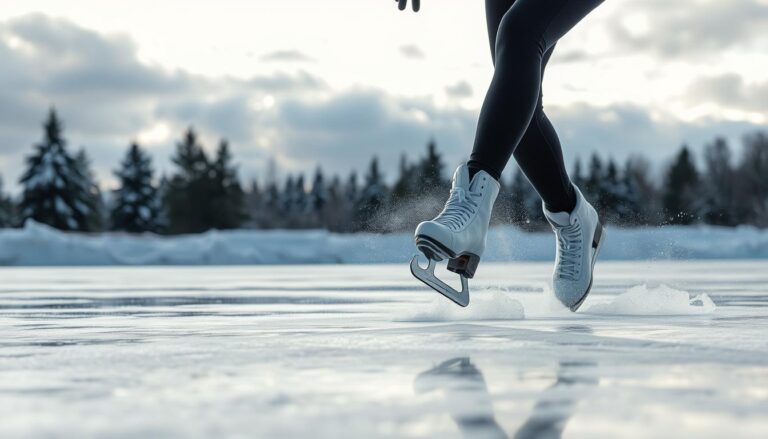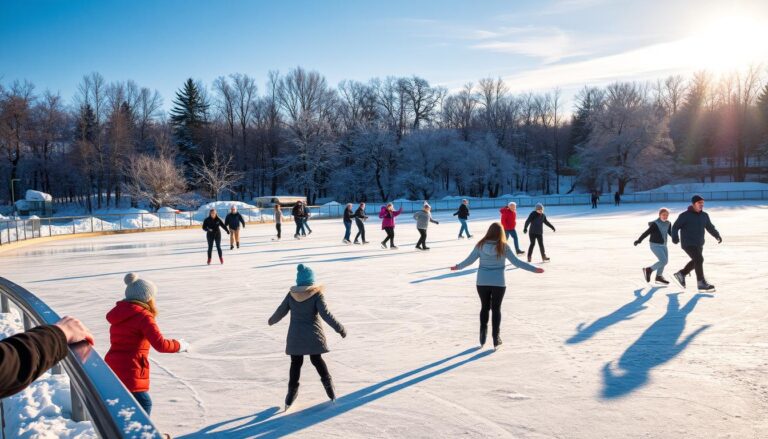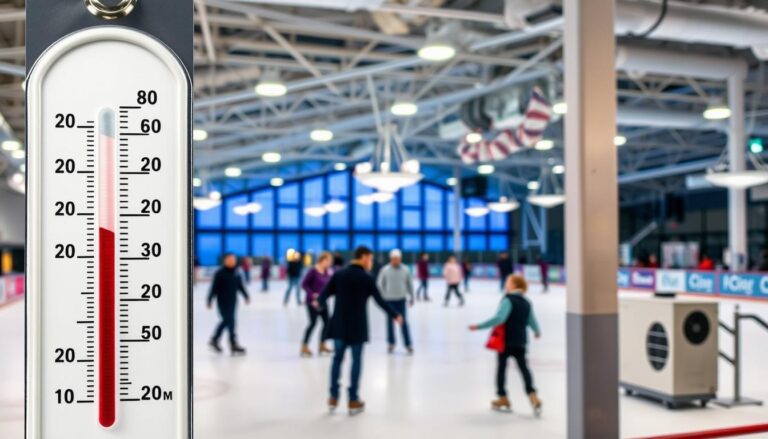Learn How to Ice Skating: Tips for Beginners
Imagine standing on the crisp, smooth surface of an ice rink, your heart racing with anticipation. Learning to ice skate might seem scary at first. But with the right help, anyone can go from a wobbly beginner to a smooth glider. This guide will show you how to master this exciting winter sport.
Ice skating is more than just fun – it’s a great workout. It improves balance, coordination, and brings joy. Your adventure begins here, whether you dream of elegant figure skating or just want to have fun with friends and family.
Starting on the ice can be nerve-wracking, but remember, pros were beginners once. The secret is knowing the basics, picking the right gear, and practicing to build confidence. This guide will make learning ice skating easy and fun.
You’ll learn how to pick the best skates and glide your first steps. You’ll find out all you need to know about starting ice skating. Get ready to enjoy sliding, get stronger, balance better, and make memories that will last forever.
Are you ready to go from a nervous beginner to a confident skater? Let’s explore the world of ice skating together and discover your skills, one glide at a time.
Essential Ice Skating Equipment for Beginners
Starting to ice skate takes more than bravery—it needs the right gear. For beginners, the right equipment can turn a tough time into a fun adventure.
Choosing the Right Ice Skates
Finding the perfect pair of skates is your first step. A good fit is key for comfort and control. Here are important things to think about when picking ice skates:
- Make sure they fit snugly with little heel movement
- Choose skates that match your skating style (recreational, figure, or hockey)
- Think about the boot height and ankle support
- Get fitted by a pro at a skating shop
Protective Gear Must-Haves
Wearing the right gear makes learning to skate safer and more fun. Here are the must-haves for safety:
- Wear a helmet, even if you’re a beginner
- Use padded shorts or crash pads
- Don’t forget wrist guards
- Wear knee and elbow pads too
Appropriate Clothing for Ice Skating
Choosing the right clothes for the rink is important. Ice skating for beginners means wearing clothes that let you move freely and stay warm:
- Start with a thermal base layer
- Wear flexible, lightweight pants or leggings
- Choose moisture-wicking socks
- Finish with a light, warm jacket
Wearing the right gear boosts your confidence on the ice. With the right equipment, you’ll be gliding in no time!
Ice Skating Safety Guidelines and Basic Rules
Stepping onto the ice is more than just fun—it’s about knowing safety and rules. A good ice skating tutorial starts with learning the basics. These basics keep everyone safe and happy while skating.
Rink safety comes from being aware and respectful of others. When you’re learning ice skating, keep these important tips in mind:
- Always skate in the same direction (typically counterclockwise)
- Maintain a consistent speed with the flow of traffic
- Look over your shoulder before changing direction
- Stay alert and avoid sudden stops or unpredictable movements
Wearing protective gear is key to avoiding injuries. Wear a helmet, always when you’re learning. Knee and elbow pads help too, when you’re starting out.
Knowing about rink markings is also important for safety. Different colored lines show different areas:
- Blue lines: Typically mark different skating sections
- Red line: Center line of the rink
- Goal lines: Areas for more advanced skaters
Beginners should stick to less crowded spots. Practice your moves where you won’t get in the way. It’s important to communicate—make eye contact and use hand signals for your plans.
Learning ice skating takes time and patience. Always put safety first, stay calm, and enjoy the journey.
Understanding Ice Skating Fundamentals
Learning to ice skate starts with the basics. These basics help beginners feel more confident on the ice. Whether you want to get better at ice skating or are looking for online lessons, knowing the basics is key.
To become a skilled skater, focus on three main things: posture, balance, and avoiding common mistakes. These elements are essential for your progress.
Basic Skating Posture
Good skating posture is your best friend for staying stable and moving well. Here’s how to get it right:
- Keep your knees slightly bent
- Have a straight back with a slight lean forward
- Keep your arms relaxed and a bit away from your body
- Look straight ahead, not down at your feet
Balance and Weight Distribution
Staying balanced on ice is all about managing your weight. Your body is your most important tool for staying in control and avoiding falls.
| Skating Element | Weight Distribution Technique |
|---|---|
| Standing | Center weight over the middle of your blades |
| Gliding | Shift weight smoothly from one blade to another |
| Turning | Lean slightly in the direction of the turn |
Common Beginner Mistakes
- Tensing up and becoming rigid
- Looking down instead of forward
- Leaning too far back or forward
- Trying to move too quickly before mastering basic techniques
By focusing on these basic techniques, you’ll gain confidence and build a strong foundation. Remember, every pro skater began where you are now – eager to learn and enjoy ice skating.
Getting Started: First Steps on Ice
Stepping onto the ice for the first time can feel scary. But, with the right approach, it becomes an exciting adventure. Your first moments on the rink are key for building confidence and learning basic skills.
Before you hit the ice, take a moment to prepare. Remember these beginner strategies:
- Wear properly fitted ice skates that support your ankles
- Hold onto the rink wall for initial support
- Keep your knees slightly bent for better balance
- Look forward, not down at your feet
Pro tip: Think of your first ice skating experience like learning to ride a bicycle – it takes practice, patience, and a positive attitude.
When you first step onto the ice, move slowly and deliberately. Start with small “penguin steps” to get used to the slippery surface. These short, careful movements help you build confidence and muscle memory for skating.
Learning to fall safely is just as important as learning to skate. If you lose balance, try to fall to the side and avoid using your hands to break the fall. Protective gear like knee pads and wrist guards can give you extra confidence.
- Start near the rink wall for support
- Keep your weight centered
- Practice standing stil before moving
- Take deep breaths to stay calm
Remember, every professional skater started exactly where you are now – taking those first tentative steps on the ice. Embrace the learning process, stay patient with yourself, and enjoy the journey of mastering this exciting skill.
Ice Skating How to: Step-by-Step Guide
Learning ice skating takes patience, practice, and the right steps. This guide will teach you the basics to glide smoothly on the ice. It’s perfect for beginners or those looking to improve their skills.
Forward Gliding Techniques
Mastering the glide is key to ice skating. Begin by finding your balance and standing comfortably. Here’s how to glide forward:
- Keep your knees slightly bent
- Distribute your weight evenly
- Look ahead, not down at your feet
- Push off gently with alternate feet
Stopping Methods
Knowing how to stop is important. Beginners should learn these basic stops:
| Stopping Technique | Difficulty Level | Best For |
|---|---|---|
| Snowplow Stop | Beginner | First-time skaters |
| T-Stop | Intermediate | More confident skaters |
| Hockey Stop | Advanced | Experienced skaters |
Basic Turning Movements
Turning on the ice is essential. Start with gentle, wide turns and get more confident as you go:
- Shift your weight slightly to the inside edge of the turning foot
- Point your body in the direction you want to turn
- Use your arms for balance and momentum
- Practice turning in both directions
Improving takes time. Don’t worry if you struggle at first. Keep practicing and stay positive to get better.
Building Confidence on Ice
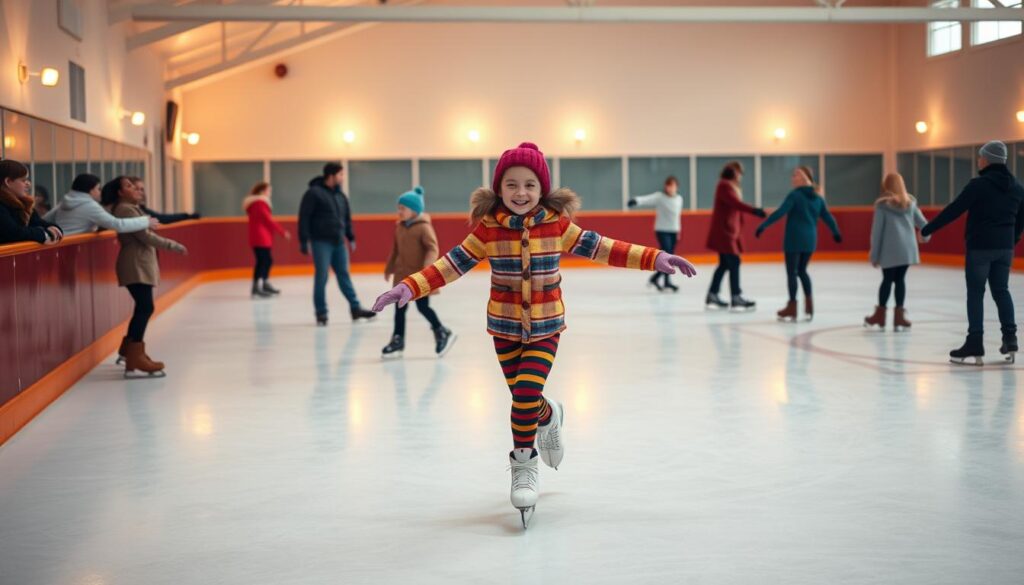
Stepping onto the ice for the first time can feel intimidating for ice skating beginners. Confidence is the secret weapon that transforms nervous newcomers into smooth skaters. Building self-assurance on the ice isn’t just about physical skills – it’s a mental game that anyone can master.
Developing confidence in ice skating requires a strategic approach. Start by understanding that every expert skater once stood exactly where you are now – uncertain but determined. Your mindset plays a critical role in improving ice skating skills.
- Visualize success before hitting the ice
- Practice balance exercises off-ice
- Start with small, achievable goals
- Celebrate every minor improvement
Mental preparation is just as important as physical practice. Close your eyes and imagine yourself gliding smoothly across the rink. This visualization technique helps reduce anxiety and builds inner confidence. Professional skaters use this method to overcome performance nerves and improve their skills.
Practical strategies can help you overcome common fears:
- Wear protective gear to feel more secure
- Take lessons from a professional instructor
- Practice in less crowded rink times
- Learn falling techniques to reduce injury risk
Remember, falling is part of the learning process. Each stumble is an opportunity to grow stronger and more skilled. Ice skating for beginners is about patience, persistence, and believing in yourself. Your confidence will grow with every minute you spend on the ice.
Mastering Forward Skating Techniques
Ice skating is all about dedication and practice. Your forward skating technique is key. It turns you from a beginner to a confident skater.
Having a strong stride is essential for improving. Ice skating drills help you perform better and build muscle memory.
Stride Development Fundamentals
A good stride has a few important parts:
- Proper body alignment
- Powerful push-off technique
- Smooth weight transfer
- Consistent rhythm
Speed Control Strategies
Learning to control your speed takes practice. It’s about how you distribute your weight. You can change your speed by:
- Adjusting your ankle angle
- Changing your leg position
- Engaging your core muscles
Edge Control Basics
Edge control is for advanced skaters. Inside and outside edges help you move smoothly on the ice. Practice these to get better at skating.
Focus on these basics to become a skilled skater. Remember, practice and patience are essential for mastering ice skating.
Essential Stopping Techniques for Beginners
Learning how to stop on ice is key for beginners. It boosts your confidence and keeps you safe. Guides on ice skating always stress the need to control your movements.
There are several stopping techniques for beginners. Each one needs practice and the right body position to do well.
- Snowplow Stop: The most beginner-friendly technique
- Push heels outward
- Create a wedge shape with skates
- Gradually increase pressure to slow down
- T-Stop: A more advanced stopping method
- Drag one skate perpendicular behind the other
- Apply gentle pressure on the dragging blade
- Keep upper body balanced
When learning to stop, keep your weight right. Bend your knees a bit and keep your center of gravity low. This helps you balance and control during stops.
Common mistakes include:
- Staying too rigid
- Looking down instead of forward
- Tensing up during the stop
Practice these tips in a safe place, with help from a pro. Start slow and build your confidence in stopping.
Learning Basic Ice Skating Turns
Turning is a key skill that boosts your ice skating abilities. It makes your skating experience better. As you get better, mastering different turns will make you more confident and in control.

To turn well, you need to know how to use your edges and position your body. Ice skating skills grow with practice and the right technique.
Inside Edge Turns
Inside edge turns help you move smoothly on the ice. To do an inside edge turn:
- Put your weight on the inside edge of your blade
- Lean a bit into the turn
- Keep your body straight and centered
- Practice slow, gentle movements
Outside Edge Turns
Outside edge turns need a different approach. They involve:
- Putting your weight on the outside edge of your blade
- Keeping your posture balanced
- Using your arms for balance
- Practicing smooth weight shifts
Three-Turn Basics
The three-turn is a basic technique that combines edge work and body movement. It’s called the three-turn because it looks like the number three on the ice.
- Begin with a forward glide
- Move your weight to the inside edge
- Turn your body while staying balanced
- Finish the turn smoothly
Pro tip: Practice these turns slowly and consistently to build muscle memory and confidence on the ice.
Common Challenges and Solutions
Ice skating can seem scary for newbies, but knowing common challenges helps. Every beginner faces obstacles that can make learning tough. The trick is to be patient and use smart techniques.
Beginners often face several big challenges on the ice:
- Balance and stability issues
- Fear of falling
- Weak ankle support
- Coordination difficulties
- Lack of proper technique
To overcome these challenges, muscle memory and consistent practice are key. Beginners should work on building core strength and flexibility. This helps improve their skating.
Here are some ways to help novice skaters:
- Take professional lessons to learn proper techniques
- Practice off-ice exercises to improve balance
- Use protective gear to build confidence
- Start with short skating sessions
- Watch tutorial videos for visual guidance
Beginner ice skating gets easier when you face challenges positively. Remember, every experienced skater was once a beginner. They learned and grew with each step on the ice.
Advancing Your Skills: Intermediate Moves
Mastering ice skating takes courage and practice. Intermediate moves open a new world of fun on the ice. They turn you from a beginner into a confident skater.
Ready to improve your ice skating? Let’s look at three key moves that will challenge and inspire you.
Backward Skating Introduction
Backward skating is key to mastering ice skating. It might seem hard at first, but with the right help, you’ll glide backward easily.
- Start with a stable forward position
- Shift weight slightly and turn shoulders
- Push with inside edges of skates
- Maintain low center of gravity
Crossovers Basics
Crossovers help you stay fast and turn smoothly. They need coordination and balance.
- Begin with a comfortable skating stance
- Practice lifting one foot over the other
- Alternate crossing feet while moving
- Keep upper body aligned
Simple Spins
Spinning adds an artistic touch to your skating. Start with basic one-foot spins to build confidence and control.
| Spin Type | Difficulty Level | Key Technique |
|---|---|---|
| Two-Foot Spin | Beginner | Rotate in place with both feet |
| One-Foot Spin | Intermediate | Lift one foot while spinning |
| Scratch Spin | Advanced | Tight, rapid rotation on one foot |
Practice makes perfect! Each move needs patience and regular practice. Don’t worry if you struggle at first. Break each move into smaller steps and practice often.
Practice Drills for Skill Development
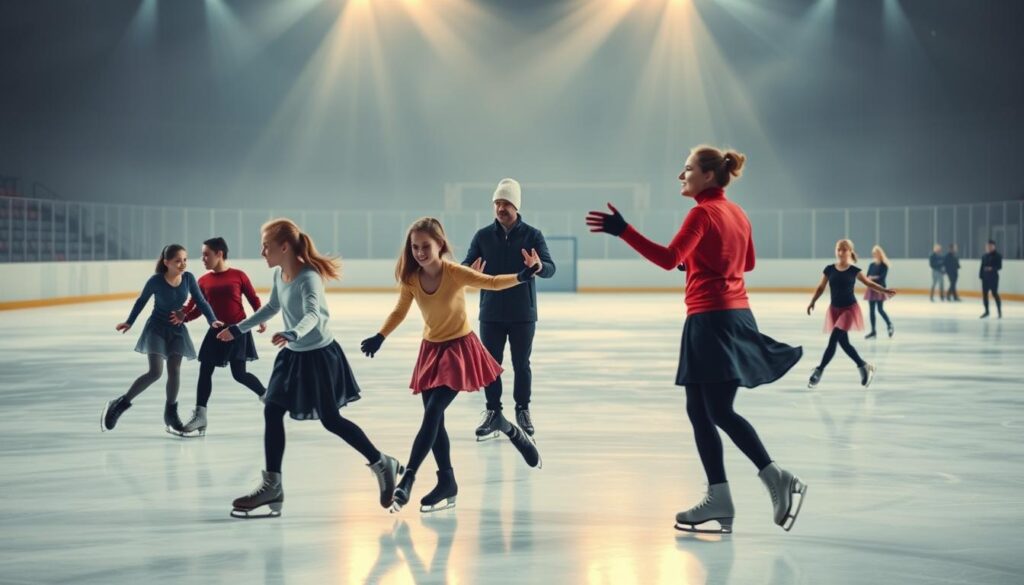
Getting better at ice skating takes hard work and smart drills. These exercises will boost your skills and confidence on the ice. They’re great for beginners and those looking to get better.
Don’t forget about off-ice training. It’s as important as skating itself. Start with basic exercises that make your balance and core stronger:
- Single-leg balance holds for 30 seconds
- Lateral lunges to improve leg strength
- Ankle mobility exercises
- Plyometric jumps to build explosive power
On-ice drills focus on key skating skills:
- Glide and Hold Drill: Practice balancing on one skate while gliding
- Stopping technique repetitions
- Edge control exercises
- Crossover practice in both directions
Experts say to make these drills a regular part of your training. Being consistent is key. Start with 15-20 minutes of focused practice, then increase as you get better.
Keep track of your progress by recording your drills. Many skaters use video review to spot areas for improvement quickly.
Indoor vs Outdoor Ice Skating Tips
Ice skating is fun whether you skate indoors or outdoors. For beginners, knowing the differences between these places can help a lot. It makes learning to skate more fun and effective.
Indoor rinks have smooth, consistent ice. They are great for beginners. Here’s why:
- Predictable ice conditions
- Maintained temperature
- Professional lighting
- Safety barriers
Outdoor skating is different and exciting. It needs special skills and preparation.
Outdoor skating has its own challenges:
- Ice thickness and stability
- Weather conditions
- Surface irregularities
- Additional safety gear
Skaters should check the ice thickness before skating outside. You need at least 4 inches of solid ice. Wear layers, carry safety gear, and skate with a friend.
Each place requires different skills. Indoor rinks teach the basics. Outdoor skating tests and improves your skills.
Maintaining and Caring for Your Equipment
Keeping your ice skating gear in top shape is key for both performance and safety. Your skates are like precision tools that need regular care. This care ensures they glide smoothly and last longer. Following ice skating tips for equipment maintenance helps protect your investment and makes skating more enjoyable.
For professional skaters, caring for their gear is more than just a quick clean. A systematic approach to maintaining your ice skating equipment extends its life and boosts your skating skills.
Skate Sharpening Essentials
Sharpening your blades is vital for ice skating. Dull blades can affect your balance and control. Here are some essential tips for blade maintenance:
- Sharpen blades every 15-20 hours of skating time
- Use professional sharpening services for precise results
- Check blade edges for nicks or uneven wear regularly
Equipment Storage Best Practices
Storing your gear right helps prevent damage and keeps it in good condition. Here are some ice skating tips for storing your equipment:
- Store skates in a dry, room-temperature environment
- Use blade guards when walking off the ice
- Wipe blades dry after each use to prevent rust
Recognizing When to Replace Gear
Knowing when to replace your gear is important for safety and performance. Look out for these signs:
| Equipment Part | Replacement Indicators |
|---|---|
| Skating Blades | Significant rust, deep scratches, or uneven edges |
| Boot Structure | Visible cracks, broken eyelets, or weakened ankle support |
| Lining | Excessive wear, torn padding, or reduced comfort |
Pro tip: Invest in quality equipment and maintain it consistently to maximize your skating performance and enjoyment.
Finding Ice Skating Classes and Resources
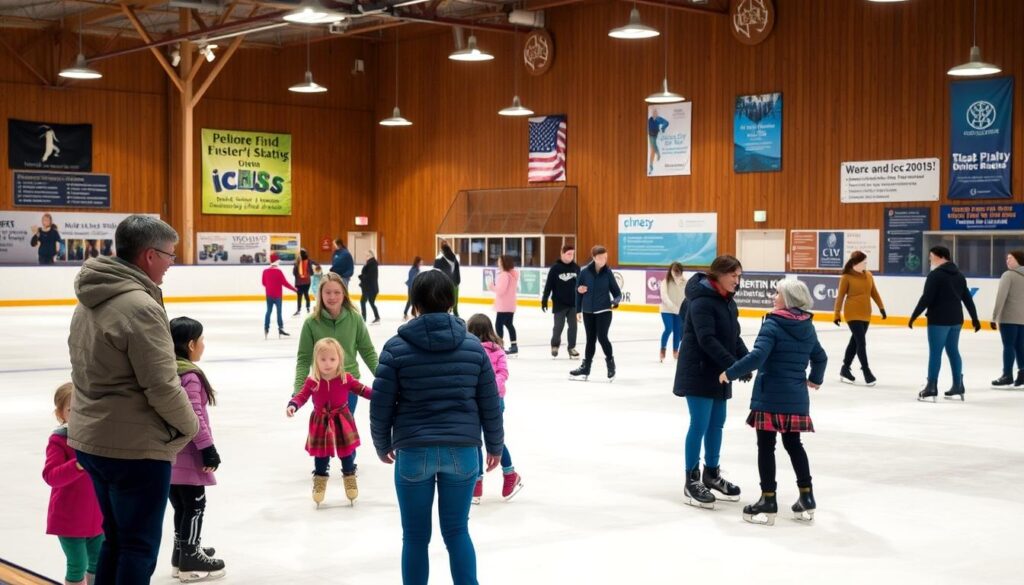
Looking for the right ice skating lessons online can change your skating journey. It can go from unsure to amazing. Whether you’re starting from scratch or want to get better, there are many ways to learn.
Finding ice skating tutorials is now super easy. Skaters can pick from different learning styles that match their needs and schedules.
- Online Video Tutorials
- Virtual Private Coaching
- Group Skating Classes
- Local Rink Instruction Programs
When picking ice skating lessons online, think about these important things:
| Learning Method | Pros | Skill Level |
|---|---|---|
| Online Video Tutorials | Flexible scheduling, affordable | Beginner to Intermediate |
| Virtual Private Coaching | Personalized instruction, direct feedback | All Levels |
| Local Rink Classes | Hands-on learning, immediate correction | Beginner to Advanced |
Groups like U.S. Figure Skating have great resources for skaters. Their websites have lots of tutorials for all levels.
Here are some top sites for ice skating lessons:
- Skate Canada Online Learning
- Professional Skating Association Resources
- YouTube Skating Channels
- Specialized Skating Instruction Websites
Take time to find the best way to learn that fits your goals, budget, and schedule. Your skating future is waiting!
Conclusion
Mastering ice skating is an exciting journey that mixes skill, balance, and joy. You’ve learned a detailed guide to go from a nervous beginner to a confident skater. This guide offers a strong base for improving your ice skating skills at any level.
Every time you glide on the ice, you make progress. Whether you’re working on basic moves or trying more complex ones, keep going. Remember, even pros started where you are today, with hard work and a desire to learn. Each time you skate, you get closer to your goals, building muscle and confidence.
Your ice skating path is special and yours alone. Don’t compare yourself to others; focus on your own growth. Enjoy the learning, celebrate small wins, and be patient with yourself. The skills you’ve picked up will not only make you a better skater but also improve your body coordination and fitness.
Are you ready to improve your skating? Get your skates, find a local rink, and start practicing. The ice is ready for you to write your own skating story. Share your journey, connect with other skaters, and most importantly, have fun every step of the way.

